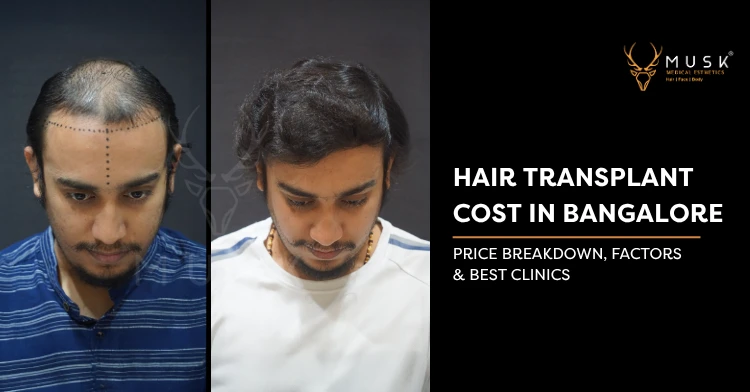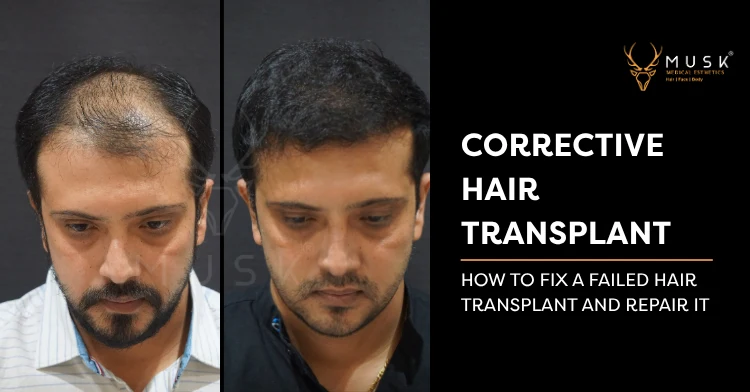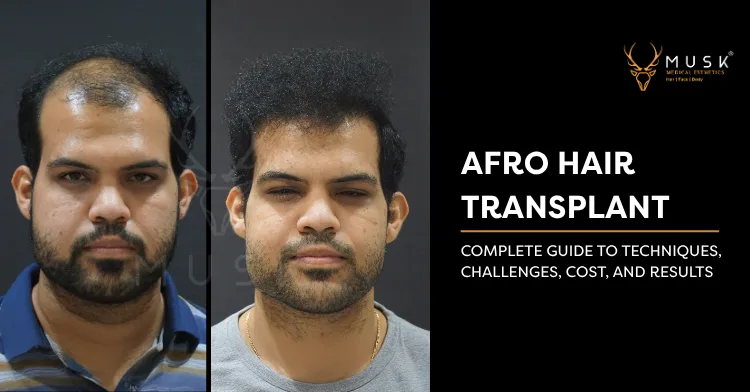Mature Hairline Vs Receding Hairline: A Detailed Guide

As we age, our hairline naturally undergoes changes. These changes can often be a source of concern, especially when we notice them starting at a younger age. It’s important to differentiate between a mature hairline and receding hairline to understand if there’s reason for worry.
A mature hairline is a natural process that typically begins around the age of 17. Characterized by an even upward movement at the temples, it often results in a “V” shape or widow’s peak.
In contrast, a receding hairline is a more pronounced hair loss that extends beyond the mature hairline. It often manifests in an uneven, “M”-shaped pattern and is accompanied by active hair shedding and thinning.
This article explores the difference between both of these hairlines including the information that helps to identify the difference.
What is Mature Hairline?
A maturing hairline is a natural process that occurs as we age. It involves the hairline gradually moving upward evenly at the temples. This typically begins around the age of 17 and can result in a “V” shape at the front, sometimes referred to as a “widow’s peak”. This process usually stabilizes between the ages of 25 and 27.
Characteristics of Mature Hairline
A key characteristic of a maturing hairline is the way it changes its position. With a maturing hairline, the hairline gradually recedes evenly from its original teenage position, typically moving back by 1 to 2 centimeters.
Unlike a receding hairline, which is often a sign of hair loss, a maturing hairline is a normal part of aging. It’s a common occurrence and doesn’t necessarily indicate any underlying health issues.
Causes of Mature Hairline
- Aging: As people get older, their hairline naturally recedes slightly, which is considered a normal part of the aging process.
- Genetics: Genetic factors play a significant role in determining the pattern and timing of hairline changes. If your parents or grandparents experienced a mature hairline, you might too.
- Hormonal Changes: Fluctuations in hormones, particularly androgens, can influence hairline changes. This is a normal part of growing older and is often related to changes in hormone levels over time.
- Family History: If there’s a history of a mature or receding hairline in your family, you’re more likely to experience similar changes as you age.
Early Signs of Mature Hairline
A mature hairline is backed by a gradual recession, at the temples, it creates a slight V-shape or gentle curve. On the early phase, you may notice your hairline becoming slightly higher or more pronounced, but it won’t involve significant thinning or bald spots.
Is Mature Hairline a Sign of Balding?
A receding hairline is influenced by the same hormones as a maturing hairline, specifically testosterone and dihydrotestosterone (DHT). However, a maturing hairline is typically a normal, gradual change that occurs with age and is not usually an indicator of genetic hair loss.
If you observe that your maturing hairline continues to recede beyond the usual extent or is accompanied by significant thinning at the temples or crown, it is advisable to consult a hair specialist. This could indicate the development of male pattern baldness.
What is Receding Hairline?
A receding hairline is a more significant hair loss issue. Unlike a maturing hairline, which is a normal part of aging, a receding hairline can be a sign of underlying hair loss conditions, such as male pattern baldness or female pattern baldness.
Characteristics of Receding Hairline
A receding hairline typically moves back more noticeably at the temples, forming an M-shaped pattern. Over time, this pattern deepens as hair loss at the temples becomes more pronounced, leading to overall recession of the hairline.
This progression can be accompanied by thinning at the crown and, in some cases, complete baldness on the top of the head. The severity of a receding hairline is classified using the Norwood Scale.
Causes of Receding Hairline:
- Genetics: Hereditary factors are a primary cause. If family members have experienced a receding hairline or pattern baldness, you may be predisposed to similar changes.
- Hormonal Changes: Hormones, particularly androgens like testosterone, can affect hair follicles, leading to hair thinning and recession. This is common in conditions like androgenetic alopecia.
- Age: As people age, hair follicles can shrink, leading to a gradual recession of the hairline.
- Medical Conditions: Conditions such as thyroid disorders, autoimmune diseases, or alopecia areata can contribute to hair loss and a receding hairline.
- Medications: Certain medications, such as those for high blood pressure, depression, or chemotherapy, can cause hair loss as a side effect.
- Stress: Chronic stress can impact hair growth cycles and potentially contribute to a receding hairline.
- Nutritional Deficiencies: Poor diet or deficiencies in nutrients like iron, vitamin D, or B vitamins can lead to hair loss and thinning.
- Traction Alopecia: Frequent hairstyles that pull tightly on the hair, such as ponytails or braids, can cause hairline recession over time.
Early Signs of Receding Hairline
Spotting the early signs of a receding hairline is crucial for taking proactive steps against male pattern baldness. Although this condition develops gradually over the years, there are key indicators you can look for.
One of the most noticeable signs is a change in your hairline. Comparing recent photographs with older ones can reveal this change if you don’t notice it directly in the mirror. A receding hairline often manifests as noticeable hair loss at the temples, forming an M-shape pattern. Additionally, you might observe increased hair shedding when washing or brushing your hair.
Is Receding Hairline a Sign of Balding?
While only a hair specialist can accurately diagnose your hair and scalp condition, receding hairlines are often linked to alopecia. For men, it is commonly one of the earliest signs of male pattern baldness.
For women, a receding hairline might be related to traction alopecia if you frequently wear tight hairstyles or heavy extensions that place stress on your hairline. Additionally, it could indicate frontal fibrosing alopecia, particularly if you are postmenopausal, as the risk of developing this condition increases significantly after menopause.
How to Diagnose Your Hairline?
To diagnose your hairline, start by examining its shape and position. Compare it with past photos to identify any noticeable changes. Look for signs of recession, such as a mature hairline, which typically recedes slightly at the temples, versus more significant recession indicative of pattern baldness.
Assess the thickness of your hair and observe any thinning or increased scalp visibility. Monitor for excessive shedding and miniaturized hairs, which may signal hair loss.
Consider your age and family history, as a mature hairline is common in late teens to early 30s, and family history of pattern baldness can be a factor.
For a definitive diagnosis, consult a dermatologist or trichologist to assess your hairline and determine the appropriate course of action.
Mature Hairline vs Receding Hairline
Onset and Progression
A mature hairline typically begins in the late teens to early 30s with a gradual, subtle recession. In contrast, a receding hairline is more pronounced and progressive, becoming increasingly noticeable over time.
Appearance
A mature hairline features a mild recession, often noticeable at the temples, and may form a slightly defined or “M” shape. A receding hairline, however, shows significant recession, with distinct “M” shape or bald patches, especially at the temples and crown.
Hair Density
With a mature hairline, hair density remains relatively stable without significant thinning. However, a receding hairline is commonly associated with thinning hair and increased scalp visibility.
Causes
A mature hairline is caused by natural aging, genetic factors, and normal hormonal changes. A receding hairline is often linked to genetic predisposition, hormonal imbalances (like elevated androgens), medical conditions (such as thyroid disorders or alopecia areata), and lifestyle factors (like stress or poor nutrition).
Impact
A mature hairline is generally considered a normal part of aging and is not usually a cause for concern. A receding hairline, however, often indicates androgenetic alopecia or other hair loss conditions and may require treatment or management.
How to Treat Mature Hairline?
A mature hairline is usually a natural part of aging and often doesn’t require treatment. However, to maintain overall health and address any concerns, you should focus on maintaining a healthy lifestyle which suggests eating a balanced diet, stress management, and avoiding such hairstyles that place excessive tension on the hair.
Above all, proper haircare is also essential. Try using gentle shampoos and conditioners, it will help you maintain scalp health while avoiding harsh treatments and excessive heat styling.
How to Treat Receding Hairline?
A male pattern boldness is primarily a hereditary condition, practically it’s not possible to prevent a receding hairline from initially developing. However, there are a few treatments which can help slow down the progression or reverse a receding hairline.
Minoxidil
A widely used non-surgical treatment, available in foam or topical solution forms. It has been proven to promote hair regrowth and enhance the strength and health of existing hair. By stimulating hair follicles, minoxidil can aid in the regeneration of hair.
Finasteride
Another effective option for treating male pattern baldness. This medication functions as a 5-alpha-reductase enzyme blocker, which inhibits the conversion of testosterone into dihydrotestosterone (DHT). Since DHT is a hormone linked to hair loss in men, finasteride can slow down hair loss and encourage new hair growth.
PRP Hair Treatment (Platelet Rich Plasma Therapy)
A regenerative approach that involves injecting concentrated platelets derived from your own blood into the scalp. This treatment is designed to restore hair and promote healing. Typically, several PRP sessions are scheduled over a period of a few months to achieve optimal results.
Hair Transplant Treatments for Receding Hairline
Hair transplant procedures can be an effective solution for addressing a receding hairline, especially when non-surgical treatments have not yielded satisfactory results.
There are two primary methods of hair transplant:
1. Follicular Unit Transplantation (FUT)
In FUT hair transplant, a strip of skin with hair follicles is removed from a donor area, usually the back of the head. The strip is then divided into individual follicular units, which are transplanted into the thinning or receding areas of the scalp. FUT allows for the transplantation of many follicles in one session and is often preferred for its efficiency in covering large areas.
2. Follicular Unit Extraction (FUE)
FUE hair transplant is a minimally invasive process, it involves the extraction of individual hair follicles directly from the donor area using a small punch tool. These follicles are then implanted into the targeted areas of the scalp. FUE is less invasive than FUT, as it does not require a large incision, and typically results in minimal scarring.
How Can Musk Clinic Help?
A receding hairline can make someone go under confident, but not to worry as there are hair transplant treatments are available in India. If you’re facing hair loss or receding hairline, Musk Clinic has a solution for it.
At Musk Clinic, we have a team of dedicated hair transplant surgeons who study your case and offer you the most convenient hair transplant treatment for you. With our years of experience and expertise in successful hair transplant treatments, we can promise you a head full of hair that looks just like your natural hair.
Connect with us for your consultation.











